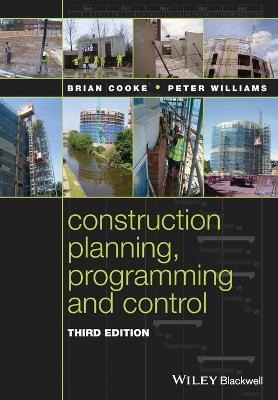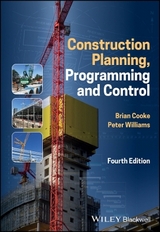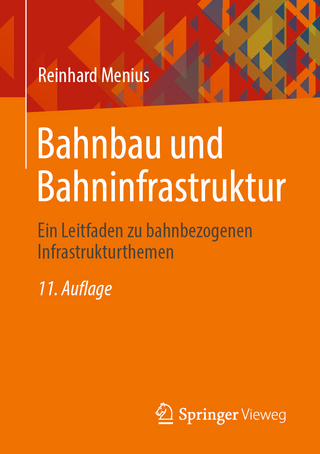
Construction Planning, Programming and Control
Wiley-Blackwell (Verlag)
978-1-4051-8380-2 (ISBN)
- Titel erscheint in neuer Auflage
- Artikel merken
This book offers a clear explanation of the principles and practice of construction planning, programming and control during the preparation and construction stages of a project.
The book is written in the context of current procurement and contractual arrangements and JCT2005, NEC3 and ICE7 contracts are covered. The statutory framework within which construction projects must be managed is explained and the topic of construction hazard and risk is covered in detail. A variety of programming techniques are explained and the development of safe construction sequences and methods is particularly emphasised. The control of time, money and resources are considered in a risk management context and a complete chapter is devoted to cash flow.
The third edition has been extensively updated and extended to include new materials on:
Hazard identification
Risk assessment
Health and safety management
CDM 2007
Construction sequences and method statements
Delay analysis
Waste management and Site Waste Management Plans
The final three chapters are devoted to individual case studies which have been selected to illustrate the practical application of the principles explained in the book and to provide examples of current procedures adopted by major contractors. The content is designed to provide a clear and comprehensive text for undergraduates on construction management, surveying and civil engineering degree courses.
Brian Cooke MSc MCIOB is a former chartered civil engineer, quantity surveyor and principal lecturer in construction management. He has lectured widely on management and financial topics both in the UK and overseas. He is currently a visiting lecturer at the University of Salford. Peter Williams MSc is a former chartered builder, chartered quantity surveyor and principal lecturer. He is currently a writer, researcher, lecturer and consultant with particular interests in contracts and finance, delay analysis and health and safety management.
Preface xi
Introduction
1 The construction industry 3
1.1 Introduction 3
1.2 Industry structure 3
1.3 Industry culture 4
1.4 Construction industry reports 5
1.5 The Latham reports 5
1.6 The Egan reports 8
1.7 The National Audit Office Report 10
2 Construction contracts 12
2.1 Contracts and planning 12
2.2 Contracts in use 13
2.3 The Housing Grants, Construction and Regeneration Act 1996 13
2.4 JCT Contracts 15
2.5 ICE Conditions 19
2.6 The Engineering and Construction Contract (NEC) 20
2.7 ACA Standard Form of Contract for Project Partnering PPC 2000 21
3 Procurement methods 23
3.1 Procurement criteria 23
3.2 The design process 24
3.3 Procurement options 26
3.4 Traditional procurement 26
3.5 Design and build 31
3.6 Management contracting 35
3.7 Construction management 36
3.8 The role of the project manager 39
3.9 Private finance initiative 40
3.10 Framework contracting 42
3.11 Prime contracting 44
3.12 Partnering 44
Part A Planning
4 Management and organisation 53
4.1 Management principles 53
4.2 Leadership styles 55
4.3 Project teams 56
4.4 Team building 57
4.5 The size of construction firms 58
4.6 The characteristics of firms 58
4.7 The small firm 59
4.8 The medium-sized firm 61
4.9 A business unit approach in a medium–large firm 64
4.10 The large firm 64
5 Tendering procedures 72
5.1 Introduction 72
5.2 Competitive tendering 72
5.3 Establishing contract leads 73
5.4 Tender pre-qualification 75
5.5 The tendering process 77
5.6 Procedures for a traditional competitive tender 78
5.7 Procedures for a design and build tender 80
5.8 Traditional competitive tendering 83
5.9 Decision to tender 83
5.10 Pre-tender arrangements 86
5.11 The site visit report 89
5.12 Tender enquiries to subcontractors and suppliers 91
5.13 Build-up of the estimate 92
5.14 Pre-tender method statement 94
5.15 Preparation of pre-tender programme 95
5.16 Build-up of contract preliminaries 96
5.17 Management adjudication of the estimate 98
5.18 Analysis of tender performance 101
6 Managing the supply chain 103
6.1 Supply chain integration 103
6.2 Lean construction 104
6.3 Fast-track construction 105
6.4 Subcontractors 106
6.5 Types of subcontractor – traditional procurement 106
6.6 Types of subcontractor – management procurement 108
6.7 Work package procurement 108
6.8 Forms of subcontract 113
6.9 Construction Industry Scheme 114
7 Managing risk 116
7.1 Risk in construction 116
7.2 The Turnbull Report 117
7.3 Project risk 117
7.4 Risk management 118
7.5 Risk assessment 119
7.6 Client risk 121
7.7 Contractor risk 123
7.8 Tendering risk 126
7.9 Health and safety risk 127
7.10 Fire risk 128
8 The planning process 130
8.1 Introduction 130
8.2 Lead times 131
8.3 Work breakdown structure 133
8.4 Planning stages 133
8.5 Project planning 135
8.6 Pre-tender planning 137
8.7 Pre-contract planning 137
8.8 Contract planning 138
8.9 Planning a project 139
9 Programming techniques 143
9.1 Introduction 143
9.2 Bar charts and linked bar charts 143
9.3 Network analysis 147
9.4 Relationships between arrow diagrams, precedence diagrams and linked bar charts 150
9.5 Arrow diagrams 151
9.6 Precedence diagrams 157
9.7 Line of balance (elemental trend analysis) 165
9.8 Time-chainage diagrams 181
9.9 Accelerating the project 186
Part B Programming
10 Developing construction sequences 199
10.1 The thought process 199
10.2 Programme considerations 201
10.3 Resource considerations 205
10.4 Achieving continuity of work 205
10.5 Sequence studies 208
11 Method statements 219
11.1 Introduction 219
11.2 Definition 219
11.3 Preparation of method statements 221
11.4 Pre-tender method statement 221
11.5 Construction method statements 226
11.6 Safety method statements 232
12 Planning for safety 234
12.1 Introduction 234
12.2 Definitions 234
12.3 Legal framework 235
12.4 Health and safety policy 235
12.5 Health and safety management 238
12.6 The safety of site operations 239
12.7 Risk assessment 241
12.8 Hazard and risk 244
12.9 Planning the work 249
12.10 The Construction (Design and Management) Regulations (CDM) 1994 251
12.11 The CDM Regulations 2007 254
12.12 Health and safety training 261
12.13 Measuring performance 263
12.14 Enforcement of legislation 264
12.15 Accidents and incidents 266
12.16 Human factors 267
13 Planning the project 272
13.1 Introduction 272
13.2 Planning procedures within a large organisation 272
13.3 Pre-contract planning 273
13.4 Pre-contract meetings 275
13.5 Placing orders for subcontractors and suppliers 278
13.6 Site layout planning 279
13.7 The master programme 281
13.8 The target programme 283
13.9 Subcontractor programmes 286
13.10 Procurement programmes 286
13.11 Requirement schedules 291
13.12 Contract planning 294
14 Planning cash flow 300
14.1 Introduction 300
14.2 Client’s cash flow 300
14.3 Contractor’s cash flow 301
14.4 Cash flow forecasting 301
14.5 Credit terms in construction 303
14.6 Forecasting contract value 303
14.7 Forecasting the contractor’s income 313
14.8 Movement of money 315
14.9 Working capital 319
14.10 Improving cash flow 319
14.11 Forecast value and cash flow example 322
Part C Control
15 Project control procedures 329
15.1 Introduction 329
15.2 Control procedures within organisations 329
15.3 Definitions 331
15.4 Types of budgets 331
15.5 Preparing budgets 332
15.6 Contract budgets 332
15.7 Labour, plant and preliminaries budgets 333
15.8 Budget control procedures 336
15.9 Importance of site records 341
15.10 Meetings as part of the control process 342
15.11 Key performance indicators 346
16 Controlling time 348
16.1 Introduction 348
16.2 Time for completion 348
16.3 The contractor’s programme 349
16.4 Milestones 350
16.5 Early warning systems 350
16.6 Progress and delay 351
16.7 Progress recording 353
16.8 Delay and disruption 358
16.9 Extensions of time 361
16.10 The ‘as-planned’ programme 366
16.11 The ‘as-built’ programme 367
16.12 Delay analysis 368
16.13 Delay and Disruption Protocol 368
16.14 Delay analysis methodologies 369
16.15 Delay analysis in practice 369
16.16 Project acceleration 375
17 Controlling money 378
17.1 Introduction 378
17.2 Reporting procedures 378
17.3 Monthly cost–value reporting 380
17.4 CVR terminology 380
17.5 Cost–value reports 384
17.6 CVR case study 390
17.7 Interim valuations using S curves 391
18 Controlling resources 394
18.1 Introduction 394
18.2 Labour control 395
18.3 Materials control 401
18.4 Plant control 408
18.5 The control and coordination of subcontractors 410
Part D Case Studies
19 City Road project 425
19.1 Project description 425
19.2 Project details 425
19.3 Site constraints 425
19.4 Tender stage 429
19.5 Pre-contract stage 440
19.6 Contract stage 452
20 Eastlands project 457
20.1 Project description 457
20.2 Project details 457
20.3 Construction details 457
20.4 Organisation structure of the developer/contractor 459
20.5 Project planning 463
20.6 Method statement – tower blocks A and B 463
21 Highway project 474
21.1 General description 474
21.2 Construction strategy 474
21.3 Method statement (simplified) 480
21.4 Clause 14 programme 484
Index 485
| Erscheint lt. Verlag | 23.1.2009 |
|---|---|
| Verlagsort | Hoboken |
| Sprache | englisch |
| Maße | 173 x 246 mm |
| Gewicht | 780 g |
| Themenwelt | Technik ► Bauwesen |
| ISBN-10 | 1-4051-8380-2 / 1405183802 |
| ISBN-13 | 978-1-4051-8380-2 / 9781405183802 |
| Zustand | Neuware |
| Informationen gemäß Produktsicherheitsverordnung (GPSR) | |
| Haben Sie eine Frage zum Produkt? |
aus dem Bereich



